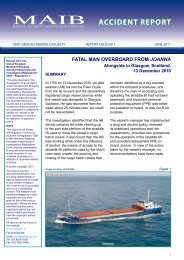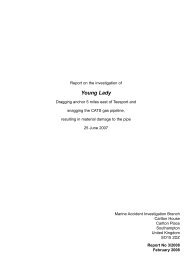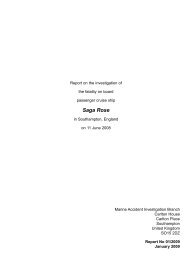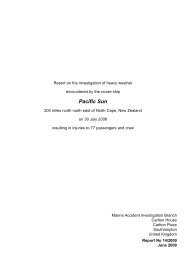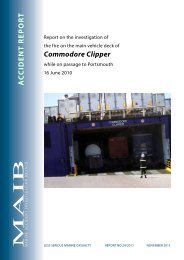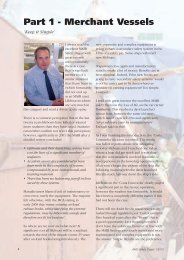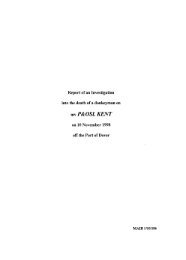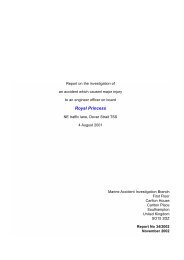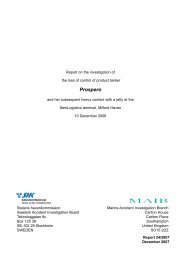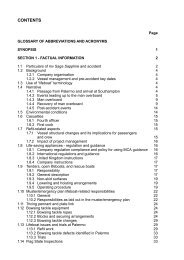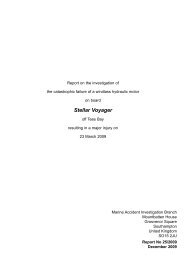Sichem Melbourne - Marine Accident Investigation Branch
Sichem Melbourne - Marine Accident Investigation Branch
Sichem Melbourne - Marine Accident Investigation Branch
Create successful ePaper yourself
Turn your PDF publications into a flip-book with our unique Google optimized e-Paper software.
2.6<br />
2.7<br />
The master and pilot were standing next to each other on the bridge wing as the<br />
incident unfolded over a period of some 10 minutes, but during this time as the ship<br />
scraped and bumped her way towards MD41, neither made any attempt to explain what<br />
they were trying to achieve. After the initial scrape leaving jetty 3, the pilot repeatedly<br />
requested hard port wheel in an attempt to retrieve the situation by swinging the<br />
vessel’s stern out before coming astern into the channel, but the more port helm he<br />
applied, the more the master thrust the bow to starboard in an attempt to lift the ship<br />
transversely into the channel. Whilst transverse lifting of the ship in this fashion may<br />
be possible in a head to stream situation, it could only be done in a stern to stream<br />
situation with the benefit of ample sea room – not in the 3.3 cables available at Coryton.<br />
Frequently, communications were passed in Russian between the bridge team during<br />
the ship’s progress eastwards, leaving the pilot unaware of the crew’s intentions and<br />
possibly affecting his decision making.<br />
As the ship cleared MD35 the pilot mentally planned to attempt a “soft landing” on jetty<br />
1, then order tugs to take the ship out; again this was not conveyed to the master.<br />
Unaware of the pilot’s thoughts, the master took command of the ship manoeuvres<br />
without officially relieving the pilot and proceeded to give orders to the chief officer and<br />
the helmsman in an attempt to bring the ship away from jetty 1.<br />
ThRUSTER CONTROL POSITIONING<br />
The master was using <strong>Sichem</strong> <strong>Melbourne</strong>’s bow thruster controls positioned on the port<br />
bridge wing. This gave him full view of the ship’s side and the ability to move the ship’s<br />
bow transversely whilst unmooring. However, the master’s body obstructed the pilot’s<br />
view of the thruster control and he was therefore unaware of what the master was doing<br />
with it. Only once on the VDR can the pilot be heard instructing the master to stop<br />
using the thruster, which he did for about 1½ minutes before resuming without the pilot’s<br />
instruction or knowledge.<br />
Indiscriminate use of the bow thruster by the master of <strong>Sichem</strong> <strong>Melbourne</strong>, without<br />
communication, served to isolate him from the pilot and from other members of the<br />
bridge team.<br />
ENGINE FAILURE<br />
<strong>Sichem</strong> <strong>Melbourne</strong>’s main engine was directly coupled to the propeller, which meant<br />
reversing was achieved by stopping the engine, altering the valve timing and then<br />
restarting the engine in the opposite direction. This process took a finite amount of<br />
time, up to 326 seconds if the ship was travelling at full sea speed.<br />
In the attempt to avoid contact with jetty 1 and MD41, the main engine was put ahead,<br />
astern, ahead, astern and finally ahead within 33 seconds. The engine orders were<br />
given far faster than the engine could possibly respond to and, although the first astern<br />
order was followed, the control system blocked the subsequent requests and held the<br />
engine stopped while the ship still had headway on. The chief engineer noticed the<br />
problem immediately and gave the chief officer instructions to bring the telegraph back<br />
to stop and press the control reset button. This was done and the engine restarted. By<br />
this time the chief officer had become concerned that engine power was needed rapidly<br />
to take further avoiding action, and he also pressed the engine limit override button.<br />
This removed pre-programmed limits on the engine’s rate of acceleration and maximum<br />
speed. The telegraph was put ahead and the engine responded quickly.<br />
21



